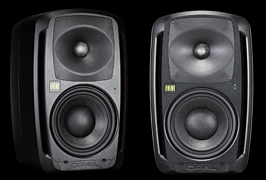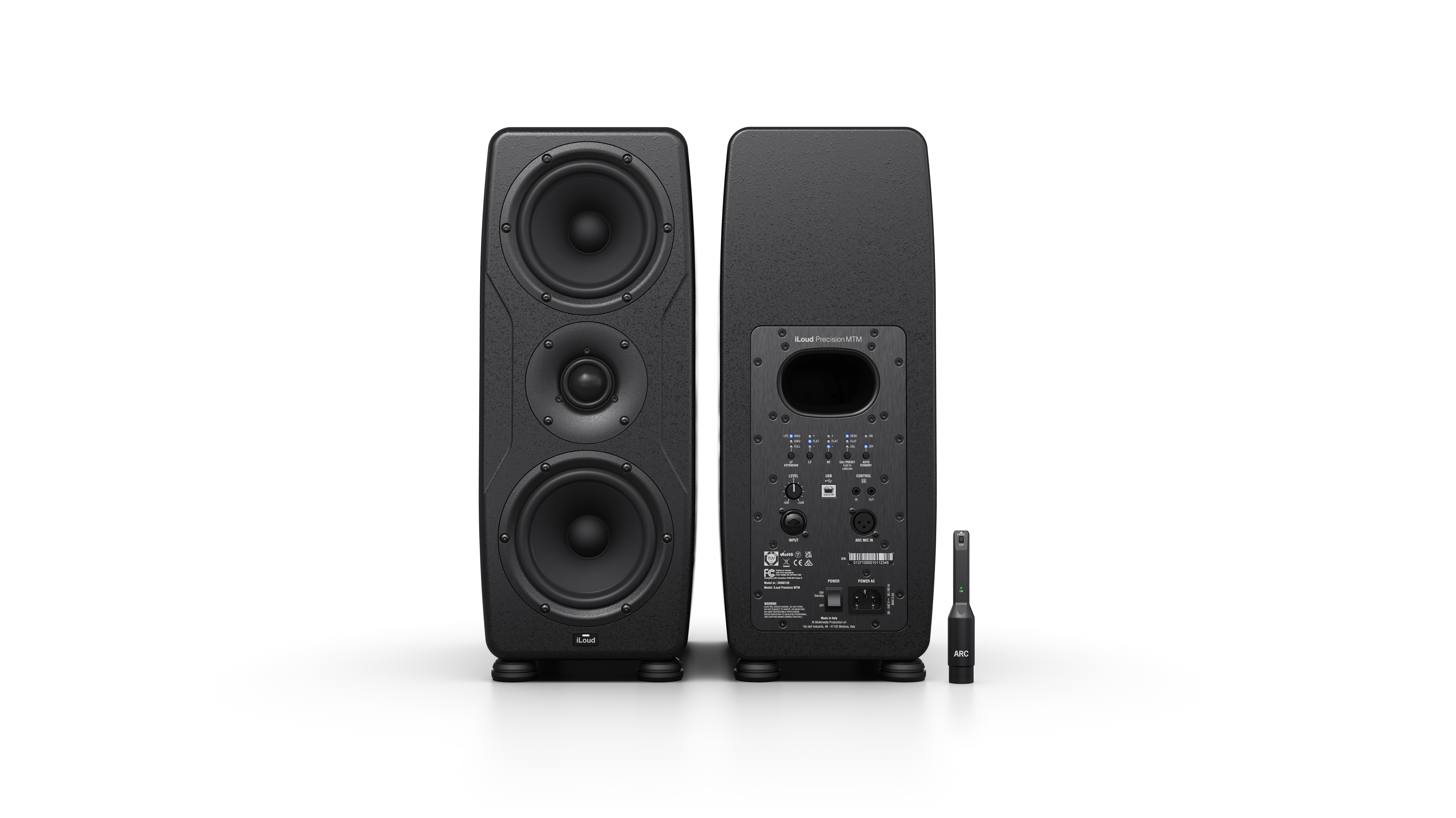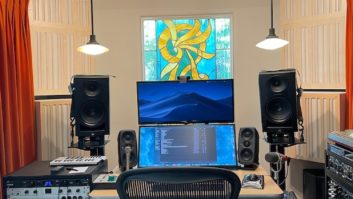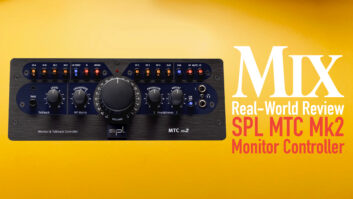
Opal’s curved enclosures have no parallel surfaces.
Named after the national gemstone of Australia, the Opals are new studio monitors from Event Electronics. Despite their relatively compact 22.6×15.4×
15-inch enclosures, Opals were intended to create a two-way system that delivers the power, accuracy and fidelity of large three-way systems.
This was no easy task. From day one, designer Marcelo Vercelli took a completely new look at the process, with the intent of creating a no-compromise monitor with world-class performance. There’s no off-the-shelf stuff here; all the components were built from the ground up, combining new and traditional technologies.
Discovering Opals
The 8-inch woofer has a neodymium motor and a low-mass, composite carbon-fiber/paper cone that’s stiff enough to provide midrange out to 10 kHz, yet delivers 35Hz bass with remarkable 30mm-plus excursion. The woofer’s dual X-Coil™ design combines an active and a parallel second voice coil for improved transient response, even under extreme workouts. The tweeter has a 1-inch beryllium/copper-alloy dome mated to a neodymium magnet structure and mounted on an asymmetrical elliptical waveguide for dispersion control in the horizontal and vertical planes. The entire HF unit and illuminated Event logo are rotatable for using Opals on their sides.
A 1.6kHz center-point, 8th-order (48dB/octave) active network handles crossover duties. The onboard bi-amplification provides 600 LF/140 HF watts of peak power via linear Class-A/B amps. Looking inside, components are top-grade, while heavy toroidal transformers and massive rear panel heat sinks contribute much to Opal’s 47-pound heft, so be wary of meter bridge placement. Full-power THD specs for the amps are in the 0.004-percent range. Neutrik combo XLR/TRS jacks handle balanced or unbalanced inputs; a 15-pin D-sub connector is provided for a planned digital input module.
Finished in a black powdercoat, the molded aluminum enclosures have no parallel surfaces, and all sides are radiused to minimize diffraction effects. Heavy interior ribs both add strength to create a solid, non-resonant enclosure, as well as break up any possibility of standing waves within the cabinet. Along the rear panel, threaded inserts (M8 Omnimount pattern) allow for various, secure wall-mount possibilities, which should be appreciated in 5.1/7.1 installations, particularly for hanging rear-surround channels.
In rear-ported designs, LF energy exiting the back of the enclosure can create unpredictable acoustical results. Opal’s front ports use a patent-pending, variable-impedance approach that combines slotted vents along either side of the drivers with flared airways that substantially reduce air-distortion artifacts.
Ready, Set, Opal
Opals self-mute during power-up, so there are no nasty whumps. Beneath a removable cover on the front baffle are knobs for tweaking Opals to personal taste or acoustical considerations. In addition to a brightness switch for the illuminated Event logo, controls include level (±6dB input sensitivity), quarter/half/full-space (LF compensation for wall or corner placement) and LF/HF shelving filters. I liked the latter: These are gentle, extremely wide-Q filters offering subtle ±1.5dB tweaks, just enough for a little fine touching.
The semiparametric, cut-only LF filter with a sweepable frequency control (40 to 280 Hz) and two six-position switches for adjusting Q (narrow to wide) and cut depth (0 to -20 dB) were highly useful. This let me selectively notch a problematic room mode with surgical precision without destroying adjacent frequencies. After this minor tweak, I was ready to go. There was no adjustment period where I felt I had to get “used to” the monitors. These sound great right out of the box.
Event plans to offer an optional software/calibration mic package for simplifying room/speaker setup, but it wasn’t shipping in time for this review. Yet thanks to the front controls, I could make tweaks without moving far from the sweet spot and, once set, the cover hides the knobs from unauthorized twiddlers. During setup, I detected no port noise (wheezing or chuffing), which can be a problem with some front-ported systems, although with nearly 750W of amps in each box, up close you can discern a bit of amplifier hiss when no signal is fed into the Opals.
In Session
Tracking drums on a large analog board, the Opals shined. They had no problem handling extreme dynamic range. The reproduction of extremely fast transients on snare and cymbals was impressive, as if I was standing in front of the kit rather than seated in the control room. Thanks to the 600W LF amps and the driver design, the level and acceleration speed to the woofers is incredible. Opals seem to have an inexhaustible amount of headroom and there was no distortion at all. The net effect was like listening to a large three-way system, with chest-thumping bass that was full, yet never out of control.
Traditionally the Achilles’ heel in most two-way designs, Opals’ excellent midrange definition and detail made a huge difference when working with vocals, letting me clearly hear nuances in mic/preamp selections when tracking or making subtle signal-processing decisions in the mix. And piano/flute/violin session playbacks showcased the invisibility of the crossover point, which was totally seamless. The balance between lows, mids and upper-end was spot-on — at any level — so mixing on Opals was an absolute pleasure. Thanks to the low-distortion performance, there was almost no hearing fatigue, even during long listening periods. You can mix on these for days on end.
Designed to match that of the woofer, the HF waveguide’s horizontal splay provides wide, even coverage with smooth response, with no off-axis smearing and a well-defined L/R soundstage over a wide listening area.
Working on a video score spotlighted Opal’s LF performance. This project had drums, bass, synth and various sound effects, including a bubbling scuba tank that was pitch-shifted down an octave, creating huge amounts of sub bass that lesser systems may not have reproduced. This LF capacity was also handy on another video project — a live concert combining stage mics with distant mics at the center and rear of the room. Here, phase adjustments were critical, and mixes made on the Opals translated precisely to larger systems, as well as small TV speakers.
Setting Standards
With the Opals, Event has created a world-class system that may become the new standard. Combining absolute accuracy and large three-way performance from a relatively compact two-way system, serious studio pros will definitely want to give these a listen.
George Petersen is Mix’s executive editor.








